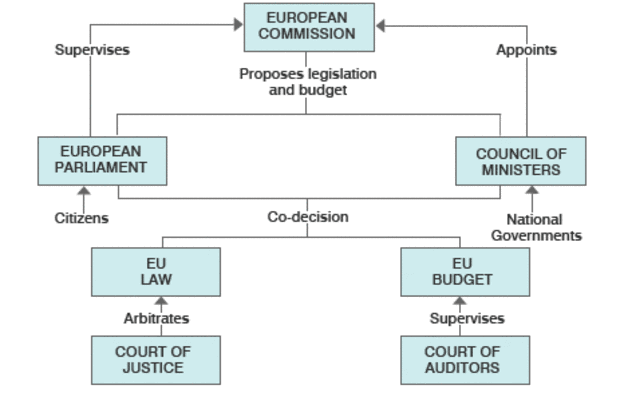
• The continent of Europe is known for its good quality of life, developed countries with lots of wealth and prosperity, a lot of chances to learn and grow, strong economic credentials, and strong political institutions.
• In light of this, it is very important for India to make strong and useful connections with the European countries. People think that India gets the same thing out of her relationships with the European Union as a whole.
• India and the EU have been talking to each other since the early 1960s. India was one of the first countries to have formal ties with the European Economic Community. With the signing of a cooperation deal in 1994, the two countries were able to do more than just trade and business together.
• The first India-EU Summit was held in Lisbon in 2000, and it was a turning point in the way the two groups worked together.
• In 2004, at the 5th India-EU Summit in The Hague, the partnership between the two was changed to a “Strategic Partnership.”
• In 2005, the two countries made a plan called the Joint Action Plan. This plan, which was reviewed in 2008, called for increasing political and economic discussion and consultation, boosting trade and investment, and bringing people and cultures together.
• The EU is one of India’s most important trading partners, and the two countries have been trying to work out a free trade deal since 2007.
Table of Contents
Areas of Cooperation
Political Partnership
• The Joint Political Statement, which was signed in 1993, made it possible for ministers to meet once a year and talk about a wide range of political issues.
• The 1994 Cooperation Agreement made the two countries’ partnership more than just about trade and business.
• Since 2000, the India-EU Summit has been in charge of a multi-tiered set of institutions for working together. During the 5th India-EU Summit in 2004, the link between the two groups was changed to a “Strategic Partnership.”
The European Commission and the EU High Representative for Foreign Affairs and Security Policy put out a strategy on India in 2018 called “A Partnership for Sustainable Modernization and Rules-based Global Order.” It sees India as an emerging global power that plays a key role in the current multipolar world and is a factor of stability in a complex region. It also calls for more political, security, and defence cooperation between India and the EU.
• The bilateral Strategic Partnership also includes 31 dialogue methods that cover a wide range of topics, such as trade, energy security, science and research, non-proliferation and disarmament, fighting terrorism, cyber security, fighting pirates, migration and mobility, etc.
• The EU is now one of India’s most important points of reference when it comes to data security and privacy laws.
Economic Ties
• Bilateral trade: The EU is India’s third largest trading partner, with €62.8 billion worth of trade in goods in 2020, or 1% of India’s total trade, after China (12%) and the US (11.7%). India is the EU’s 10th largest trading partner, with 1.8% of the EU’s total trade in goods in 2020, well behind China (16.1%), the USA (15.2%), and the UK (12.2%).
After the USA, the EU is the second biggest place where Indian goods are sent (14% of the total).
India sends the most engineering goods, medicines, gems and jewellery, other manufactured goods, and chemicals to the European Union.
Also, it is said that more than 6,000 companies from the European Union work in India, giving direct and indirect jobs to more than six million people.
• Investment: In the last ten years, the EU’s share of foreign investment going to India has gone from 8% to 18%, which is more than double. This makes the EU an important investment in India from outside the country.
With the creation of an Investment Facilitation Mechanism for EU investments in India in 2017, there is an increased focus on making it easier for EU investors in India to follow business rules.
o This mechanism makes it possible for the Indian government and the EU to work together to find answers to the issues and problems that EU investors face when doing business in India.
Also, India and the EU have been working on a Broad-based Trade and Investment Agreement (BTIA) since 2007, but India’s trade system and regulatory environment remain relatively strict.
• Preferential treatment: India benefits from the unilateral preferential tariffs under the EU Generalised Scheme of Preferences (GSP), which lowers import duties for almost 66 percent of product tariff lines to help different industry sectors in developing countries.
• Energy: After 13 years of talks, the European Atomic Energy Community (EURATOM), a civil nuclear cooperation deal, has been signed by both sides. It includes working together in the area of civil nuclear energy.
• Development cooperation: The EU is spending more than €150 million on projects in India right now. The European Investment Bank (EIB) is giving funds to the metro projects in Lucknow, Bangalore, and Pune.
Defence and Security
• The EU and India have set up a number of ways to work together on important security issues like counter-terrorism, marine security, and not spreading nuclear weapons.
• In 2018, the 6th India-EU Foreign Policy and Security Consultations were held to talk about how to make the India-EU Strategic Partnership stronger.
• The Maritime Security Centre – Horn of Africa (MSC-HOA), which was set up by the EU Naval Force (NAVFOR), is now linked to the Information Fusion Centre – Indian Ocean Region (IFC-IOR) in New Delhi.
Climate Change:
Even though the US is pulling out of the Paris Agreement and the UNFCCC, the EU and India say they are still politically committed to making them work.
• At the 2016 Summit, the India-EU Clean Energy and Climate Partnership was agreed upon. Its goal is to improve access to and spread clean energy and climate-friendly technologies, as well as to encourage research and development.
Energy cooperation is now happening on a wide range of issues, such as smart grids, energy efficiency, offshore wind and solar infrastructure, and research and development. The EU has also invested in many programmes, such as the India-EU water partnership, the solar park programme, and the Facilitating Offshore Wind in India (FOWIND) programme.
The EIB and the Indian Renewable Energy Development Agency signed a loan agreement for 200 million euros, which was one of the biggest investments. The EU and India also work closely together on the Clean Ganga project and deal with other water-related problems in a coordinated way.
• The Ministry of Earth Sciences (MoES) and the European Commission (EC) have set up a co-funding mechanism (CFM) to help support joint research projects linked to climate change and polar research that have been chosen under the European Research and Innovation Framework Programme “Horizon 2020.”
Science, Research, and Development:
The India-EU Science & Technology Steering Committee meets once a year to talk about how the two countries can work together in science.
• ISRO has worked with the European Union for a long time, since the 1970s. It has helped build the Galileo satellite guidance system for the EU.
ISRO and the European Space Agency are working together to improve how they observe the world.
A Joint Working Group (JWG) looks for ways to work together in areas like earth science, space science, space technology, and integrated uses.
A 2018 agreement between the European Commission and the Department of Space about the Copernicus project lays out a plan for sharing data and working together more in the space industry.
• India and the EU also work together on several Sustainable Development Goals (SDGs), such as the smart cities programme (SDG 11), clean water and sanitation (SDG 6), and climate action (SDG 13).
Through the Clean Energy and Climate Change Partnership, 2017, they have become important players in the fight against climate change around the world.
• Both have government systems in areas like digital communications, 5G technology, biotechnology, artificial intelligence, etc.
Maritime Cooperation
• The Joint Action Plan, which was signed in 2005, put a lot of focus on unity in the maritime area.
• Over the past few decades, both India and the EU have put a lot of focus on freedom of navigation, maritime piracy, and following the United Nations Conventions on the Law of the Sea (UNCLOS), as well as the development of the blue economy and maritime infrastructure. • Both have seen the Indo-Pacific as the new place for maritime cooperation.
• The first Maritime Security Dialogue was held online by India and the EU in January 2021.
Data Protection and Regulation
• For the first time, the Roadmap 2025 document showed the need to work together on data security and regulation.
• During the 15th India-EU Summit, both sides agreed to bring their regulatory systems closer together through a data adequacy decision to make it easier for data to flow across borders. They also agreed to talk about how to use AI and 5G in a safe and ethical way.
________________________________________
Future scope
• Trade numbers and investments: In 2021-22, trade between the two countries was worth more than $116 billion. After the U.S., the EU is India’s second biggest trading partner and second largest export market.
• Creating jobs: There are 6,000 European companies in the country that create 6.7 million jobs directly and indirectly.
• The India-Denmark Green Strategic Partnership aims to deal with climate change, wildlife loss, and pollution. The India-Nordic Summit focused on green technologies and industry transformation, which are important for growth that is sustainable and benefits everyone.
• Energy security: Energy is an important part of how India and the EU work together. Because of the effects of climate change, this part is now very important. Both groups have been looking for ways to work together to create clean energy.
• Political cooperation: India and the EU could gain from working together more on issues like terrorism and radicalization, cyber-security, coordinating on some key and important parts of foreign policy, and other humanitarian issues.
• Help from other countries: It’s important that Europe sees India as a partner for peace that cares about human rights, both in its own region and around the world.
Challenges
• Deadlock over BTIA: Talks for a Broad-based Bilateral Trade and Investment Agreement (BTIA) took place from 2007 to 2013, but they have been on hold or put on hold since then.
• Export obstacles: India’s requests for ‘Data secure’ status (important for India’s IT sector) to ease rules on temporary movement of skilled workers, relaxation of Sanitary and Phytosanitary (SPS) rules, etc., are mostly overlooked.
• There is a big trade deficit in favour of China. In 2019, India only makes up 1.9% of the EU’s overall trade in goods. This is a long way behind China, which makes up 13.8%.
• Brexit fights: In the long run, balancing global powers means that a smaller Europe without the UK, which is a key military and economic power, is much weaker. This is because China is getting stronger and the US is becoming more nationalistic.
• The EU is still mostly a trade bloc, which has made it hard to reach deals on important issues like regional security and connectivity.
• Unnecessary references to sovereign concerns. Both the Indian government’s move to get rid of Jammu and Kashmir’s special status in 2019 and the Citizenship (Amendment) Act were criticised by the European Parliament.
• The impact of China: The EU is close to China. Because it depends so much on the Chinese business. China’s Belt and Road Initiative (BRI) counts it as a major partner.
• Everyone in the EU didn’t like EAM S. Jaishankar’s funny answer about the EU buying oil from Russia because of the Ukrainian war. It still wants India to say bad things about Russia.
What the EU wants from India
• Getting less dependent on China: Both sides need to do this because being too dependent on China makes them very exposed to Chinese aggression.
• Western lobbying: The EU knows that its supply chain is vulnerable, that being too dependent on China is a risk, and that the global community of democrats needs to be strengthened.
• Health care: The ongoing pandemic has shown that world health needs to work together. India and the European Union (EU) have asked the World Health Organisation (WHO) to change.
• India is still mostly seen as a big market, not a partner, by the EU.
• Support for multilateralism: Both sides have problems because of the trade war between the US and China and because they don’t know what the US will do. They both want to avoid a world that is divided into two camps and build an order based on rules.
India’s ties to the EU
• The U.S. stepping back from global leadership has made room for the EU and India to work together and for trilateral talks with countries in the Middle East, Central Asia, and Africa.
• Chinese Aggression: China’s growing position in Eurasia and South Asia is making both Europe and India worry about their security, politics, and economies.
• The fall of the traditional global order: trade wars, the collapse of the WTO and the TPP, etc., have shown the EU how important India’s economy is.
• BREXIT: Because its usual partner is leaving the union, BREXIT is forcing India to look for new “gateways” to Europe. The world needs to work together more on trade and politics.
• Conformity in the Indo-Pacific: The Indo-Pacific is the main way that trade and energy move around the world. Rule-based Indo-Pacific is good for everyone, including the EU.
Way forward
• A close relationship between India and the EU has important economic, political, and military effects on the current international order, which is based on crises.
• Both sides should be aware of this possibility and work hard to strengthen their relationships with each other.
• As pointed out in the EU’s 2018 strategy on India, India and the EU should look at their relationship through more than just a “trade lens” and recognise their important regional and strategic convergences.
• India can ask EU countries to join the Indo-Pacific story, both from a geoeconomic and a security point of view.
















